Related Research Articles
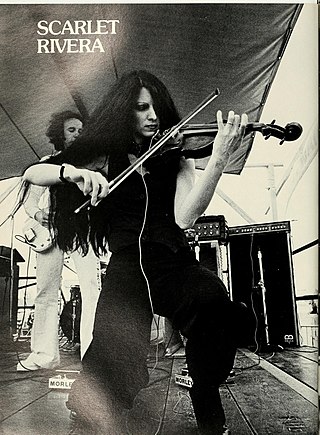
Donna Shea, better known as Scarlet Rivera is an American violinist. She is best known for her work with Bob Dylan, in particular on his 1976 album Desire and as part of the Rolling Thunder Revue.
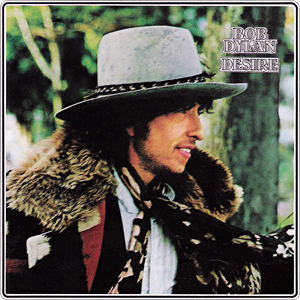
Desire is the seventeenth studio album by American singer-songwriter Bob Dylan, released on January 5, 1976, through Columbia Records. It is one of Dylan's most collaborative efforts, featuring the same caravan of musicians as the acclaimed Rolling Thunder Revue tours the previous year. Many of the songs also featured backing vocals by Emmylou Harris and Ronee Blakley. Most of the album was co-written by Jacques Levy, and is composed of lengthy story-songs, two of which quickly generated controversy: the 11-minute-long "Joey", which is seen as glorifying the violent gangster "Crazy Joey" Gallo, and "Hurricane", the opening track that tells a passionate account of the murder case against boxer Rubin Carter, who the song asserts was framed. Carter was released in 1985, after a judge overturned his conviction on appeal.

Renaldo and Clara is a 1978 American film directed by Bob Dylan and starring Bob Dylan, Sara Dylan and Joan Baez. Written by Dylan and Sam Shepard, the film incorporates three distinct film genres: concert footage, documentary interviews, and dramatic fictional vignettes reflective of Dylan's song lyrics and life.

The Rolling Thunder Revue was a 1975–76 concert tour by American singer-songwriter Bob Dylan with numerous musicians and collaborators. The purpose of the tour was to allow Dylan, who was a major recording artist and concert performer, to play in smaller auditoriums in less populated cities where he could be more intimate with his audiences.

The Bootleg Series Vol. 5: Bob Dylan Live 1975, The Rolling Thunder Revue is a live album by Bob Dylan released by Columbia Records in 2002. The third installment in the ongoing Bob Dylan Bootleg Series on Legacy Records, it documents the Rolling Thunder Revue led by Dylan prior to the release of the album Desire. Until the release of this album, the only official live documentation of the Rolling Thunder Revue was Hard Rain, recorded during the less critically well received second leg of the tour.
Sara Dylan is an American former actress and model who was the first wife of singer-songwriter Bob Dylan. In 1959, Noznisky married magazine photographer Hans Lownds; during their marriage, she was known as Sara Lownds.
"Diamonds & Rust" is a song written, composed, and performed by Joan Baez. It was written in November 1974 and released in 1975.
"Love Minus Zero/No Limit" is a song written by Bob Dylan for his fifth studio album Bringing It All Back Home, released in 1965. Its main musical hook is a series of three descending chords, while its lyrics articulate Dylan's feelings for his lover, and have been interpreted as describing how she brings a needed zen-like calm to his chaotic world. The song uses surreal imagery, which some authors and critics have suggested recalls Edgar Allan Poe's "The Raven" and the biblical Book of Daniel. Critics have also remarked that the style of the lyrics is reminiscent of William Blake's poem "The Sick Rose".

Howard Pyle Wyeth, also known as Howie Wyeth, was an American drummer and pianist. Wyeth is remembered for work with the saxophonist James Moody, the rockabilly singer Robert Gordon, the electric guitarist Link Wray, the rhythm and blues singer Don Covay, and the folk singer Christine Lavin. Best known as a drummer for Bob Dylan, he was a member of the Wyeth family of American artists.
"Simple Twist of Fate", a song by American singer-songwriter Bob Dylan, was recorded on September 19, 1974, and was released in 1975 as the second song on his 15th studio album Blood on the Tracks.
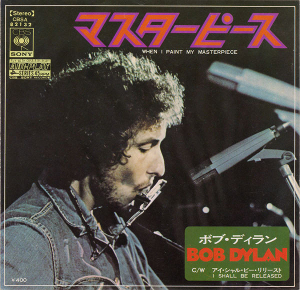
"When I Paint My Masterpiece" is a 1971 song written by Bob Dylan. It was first released by The Band, who recorded the song for their album Cahoots, released on September 15, 1971.

"Tonight I'll Be Staying Here with You" is a song written by Bob Dylan from his 1969 album Nashville Skyline. It was the closing song of the album. The song was the third single released from the album, after "I Threw It All Away" and "Lay Lady Lay", reaching #50 on the US Billboard Hot 100 chart, and reaching the top 20 in other countries. It was anthologized on the compilation albums Bob Dylan's Greatest Hits Vol. II and Playlist: The Very Best of Bob Dylan '60s.
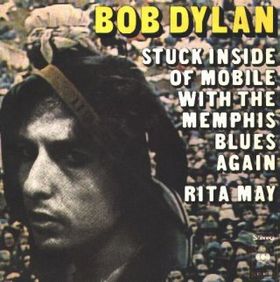
"Rita May" is a song by Bob Dylan, originally recorded during the sessions for the album Desire, but released only as the B-side of a single and on the compilation album, Masterpieces. The song is based on the 1957 rockabilly song "Bertha Lou". Some listeners believe that the lyrics of the song refer to writer Rita Mae Brown, who had complained of the lack of opportunities for casual lesbian sex.
"Romance in Durango" is the seventh song on Bob Dylan's 1976 album Desire. It was written by Dylan and Jacques Levy, who collaborated with Dylan on most of the songs on the album. The chorus contains several lines sung in Spanish, resulting in the song being released as a single in Spain in 1977. It was also released as a b-side to the Japanese single of "One More Cup of Coffee" in 1976. The song was produced by Don DeVito.
"Mama, You Been on My Mind" is a song by American singer-songwriter Bob Dylan. Written in 1964 during a trip to Europe, the song dealt with his recent breakup with his girlfriend, Suze Rotolo. Dylan first recorded the song in June of that year during a session for his album Another Side of Bob Dylan. However, the song was not included on the album, and Dylan's version remained unreleased until 1991. In total, in the 1990s and 2000s four versions were put out on Dylan's Bootleg Series of releases, including two live performances with Joan Baez from 1964 and 1975.
"You're Gonna Make Me Lonesome When You Go" is a song by Bob Dylan. Recorded in September 1974, it appeared as the fifth track on Dylan's album Blood on the Tracks, released in January 1975.
"Sara" is a song from Bob Dylan's 1976 album Desire. It is the closing song on the album. Unlike many of the songs on the album, which were written by Dylan and Jacques Levy, "Sara" was written solely by Dylan, as an autobiographical account of his estrangement from then-wife Sara Dylan. It was recorded on July 31, 1975.

Rolling Thunder Revue: A Bob Dylan Story by Martin Scorsese is a 2019 American documentary film, composed of both fictional and non-fictional material, covering Bob Dylan's 1975 Rolling Thunder Revue concert tour. Directed by Martin Scorsese, it is the director's second film on Bob Dylan, following 2005's No Direction Home. The bulk of Rolling Thunder Revue is compiled of outtakes from Dylan's 1978 film Renaldo and Clara, which was filmed in conjunction with the tour.
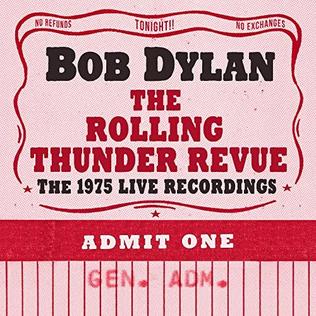
Bob Dylan – The Rolling Thunder Revue: The 1975 Live Recordings is a box set of 1975 live recordings by Bob Dylan, released on June 7, 2019. For this tour, Dylan assembled a loose collective of a backing band called Guam and played across North America for several dozen shows. The tie-in Netflix documentary film Rolling Thunder Revue: A Bob Dylan Story by Martin Scorsese was released the following week. A similar compilation was released in 2002 entitled Bob Dylan Live 1975, The Rolling Thunder Revue, as part of Dylan's ongoing Bootleg Series. That compilation was re-released on vinyl as a companion to the later release.

"One More Cup of Coffee (Valley Below)" is a song by American singer-songwriter Bob Dylan, which was released as the fourth track on his seventeenth studio album Desire (1976). The song was written by Dylan, and produced by Don DeVito. The album version of "One More Cup of Coffee (Valley Below)" was recorded on July 30, 1975, and released on Desire in January 1976. Dylan said the song was influenced by his visit to a Romani celebration at Saintes-Maries-de-la-Mer in France on his 34th birthday.
References
- ↑ Soni, Manish (2001). Mystic Chords: Mysticism and Psychology in Popular Music. New York: Algora. pp. 212–215. ISBN 1892941708.
- ↑ Dalton, David (2012). Who Is That Man? In Search of the Real Bob Dylan. London: Omnibus Press. ISBN 9780857127792.
- ↑ Varesi, Anthony (2004). The Bob Dylan Albums: A Critical Study. Toronto: Guernica. p. 176. ISBN 1550711393.
- ↑ "Isis | The Official Bob Dylan Site". www.bobdylan.com. Retrieved 2019-07-25.
- ↑ Pelly, Jenn (8 December 2020). "Fiona Apple on How She Broke Free and Made the Album of the Year". Pitchfork. Retrieved 2021-03-23.
- ↑ "Revisiting The White Stripes' blistering 2001 cover of Bob Dylan's 'Isis'". 15 May 2020. Retrieved 2021-03-23.
- ↑ "Tune Doctor : DYLAN COVERS #59 Ryan Adams - Isis/Love Sick/Mississippi/Po' Boy". Tune Doctor. Retrieved 2021-03-23.